African Rift Valley Senior Lead Keeper, Jenyva, introduces us to the CMZoo zebra brothers, Wembe and Mugambi, and walks us through their training and husbandry behaviors.
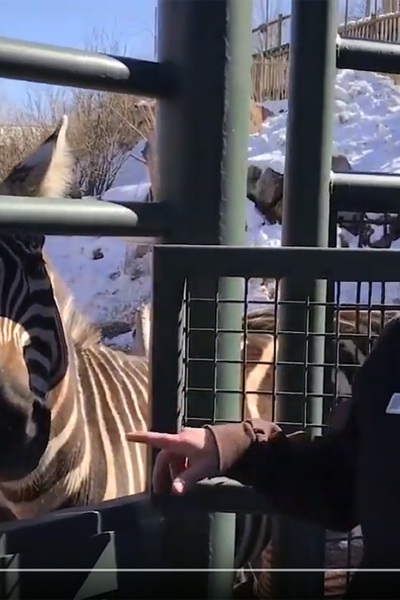

African Rift Valley Senior Lead Keeper, Jenyva, introduces us to the CMZoo zebra brothers, Wembe and Mugambi, and walks us through their training and husbandry behaviors.
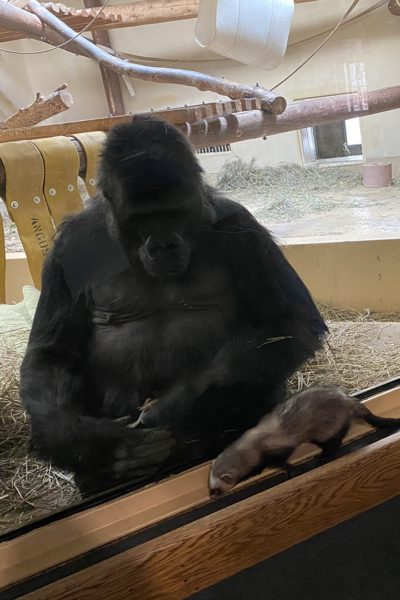

Although we’re closed to the public and missing our members and guests, things aren’t slowing down at Cheyenne Mountain Zoo. From daily animal care and enrichment to veterinary procedures, special projects and COVID-19 management, we’re operating with energy and passion to prepare for the day we can welcome you back.

“Our organization is unique because although we’re considered an attraction, we are exempt from the stay-at-home order as a critical service, so we won’t halt or slow operations in the absence of guests,” said Jeff Halter, vice president of animal care. “We have animals to feed and care for and a huge mountainside campus to keep up. Our team is enthusiastic and flexible. They’re doing a great job embracing the new responsibilities and fulfilling their normal day-to-day roles, which helps provide a sense of normalcy for our animals and for our staff.”
Animal care is always a top priority. CMZoo keepers are finding creative ways for the animals in their care to stay enriched while guests aren’t visiting. Sometimes, they can enrich two groups of animals simultaneously, by inviting them to visit each other.
“Human guests can be a form of enrichment for our great apes, who often like interacting with our guests through glass walls” said Joanna Husby, animal care manager. “Keepers have found creative ways to enrich the gorillas and orangutans, by inviting small animals like Waffles, our African cape porcupine or Alfred and Harley, our domestic ferrets, to walk the halls of Primate World.”
The visit to Primate World is enriching for the small animals because it’s entirely new terrain, with new sights, smells and sounds. Because the doors won’t open and the great ape habitats are sealed with glass walls from the inside, the ferrets, helmeted guinea fowl, porcupines and more that visit are generally free to roam all of the public spaces in the building.
The small animals’ field trips to Primate World seems to interest the apes, too.
“The Western lowland gorilla troop has been really interested in our little visitors,” said Husby. “They’ll come and sit right by the windows and watch from the other side. The gorillas will even walk from one side of the room to the other, intently watching the smaller animals.”
Keepers are continuing to train with the animals, which will hopefully avoid any training regression due to the pause in animal demonstrations and keeper talks for our guests. That consistent training allows animals to make choices in their own care, such as shifting from one area of their exhibit to another, participating in voluntary blood draws and injections, receiving ongoing hoof care and more.
“In addition to finding creative ways to keep our animals enriched and healthy, all departments in the Zoo have stepped up disinfectant procedures and distancing practices,” said Halter, who also leads CMZoo’s emergency response team.

Permanent Zoo staff are considered essential personnel, so we’re returning to work as usual, as outlined in government mandates. Employees have several options for taking time off work, should they find themselves at risk, exposed to or diagnosed with the virus.
We have socially distanced outdoor staff meetings occasionally, where we share updates and talk through concerns. Leadership keeps employees updated on the challenges our community is facing and the changes we’re embracing on a daily basis. Because the Zoo has been financially conservative for decades, we are fortunately prepared for these types of situations.
The Zoo is also embracing its role as a community resource, even while we can’t invite our community inside our gates. Through online Spring Break Zoo Camp activity videos, keeper talks, animal demonstrations and moments of #CMZooZen, our team continues to reach our fans and inspire a love for animals and the natural world. CMZoo’s social media platforms are buzzing with our timely series called Abnormally Normal.
Although we’re temporarily closed, we’re permanently committed to caring for our animals and keeping you connected to our mission, our animals and the natural world. It’s definitely an abnormal time in the world, but we’re providing special glimpses at how normal things are at the Zoo. Follow our Abnormally Normal Video Series on Facebook and YouTube! As always, our guests are enjoying the giraffe herd remotely, using our two live streaming Giraffe Cams overlooking the outdoor yard.
We’re preparing for our Association of Zoos and Aquariums (AZA) accreditation inspection, which is scheduled for this summer. The accreditation process is intense, and happens once every five years. We’re taking this time to tackle small projects around the Zoo that help prepare us for inspection. Helping us with those tasks are our guest services staff, who have worked tirelessly to take on projects outside of their usual responsibilities, to make sure the Zoo is as fresh, clean and organized as possible when we welcome AZA inspectors later this year.
Currently, the Zoo has a goal to reopen to the public as soon as April 17, 2020. However, we will take cues from our local and national government officials to see if that timeline still makes sense as we get closer to the date. For the latest updates on the Zoo’s reopening date, check out the green alert bar link at the top of the page at cmzoo.org/alerts.
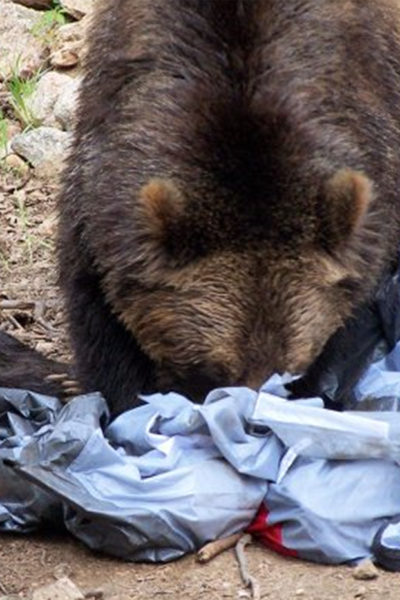

American black bears in Colorado will start coming out of hibernation soon, and they’ll be hungry after a winter in the den. Although we don’t have any native species of black bears at Cheyenne Mountain Zoo, we’re advocates for doing all we can to keep wild animals wild. No matter the species, it’s never a good idea to feed a wild animal – on purpose or by accident. In some cases, feeding wildlife is illegal.

Early risers can make a difference and save bear lives. When it’s trash day, put trash out the morning of pick-up. We have bear-safe trash receptacles throughout the Zoo, and similar models are available for residential properties. If you don’t want to invest in a bear-safe trash receptacle, keeping your trash cans in a garage or shed is a good option to help keep bears out of trouble. Bears think garbage smells amazing and if they can get into it, they will.
“With five toes on each paw, bears are incredibly dexterous,” said Rebecca Zwicker, Rocky Mountain Wild animal manager. “Over time, they learn how to use their dexterity to open doors and containers, so it’s up to us to stay one step ahead of them.”
Bears also love birdfeeders. They love sunflower seeds and other seeds, and especially love hummingbird food. When a bear eats from a birdfeeder, it’s probably going to destroy that bird feeder and eat all of the food you bought for the birds. Also, once they find a food source, they’ll often come back to that area, which creates a potential for surprise visits in your backyard. Take bird feeders down at night when bears are most active, or just hang bird feeders in the winter, when the bears are asleep and the birds are really searching for food.

Black bears can smell a meal from up to 20 miles away. Once they smell and find a campsite, they’ll start searching for food. When you’re camping, keep food outside of your tent, so you’re not inviting bears to investigate your sleeping quarters. Keep food locked in a bear-safe container or hang your food from a rope, high off the ground and away from something a bear could climb. Bears are attracted to things like s’mores and meat, but also toothpaste and coffee. If it smells interesting, a bear wants to check it out.
“Bears are intelligent, and they have really great memories,” said Zwicker. “Once they’ve found a source of something yummy, you can bet they’ll be back for more.”
Once a bear comes into human spaces, they’re given the term ‘nuisance bear.’ They’re tracked and usually only get a few ‘strikes’ before they have to be killed, or in some rare cases relocated. That’s why it’s so important that we help prevent opportunities for them to become a nuisance.
“Seeing a bear in the wild is magical,” said Zwicker. “Their presence is part of what makes Colorado so special, but it’s up to us humans to protect these curious creatures from themselves. If you can follow these simple tips, you could save a bear’s life.”
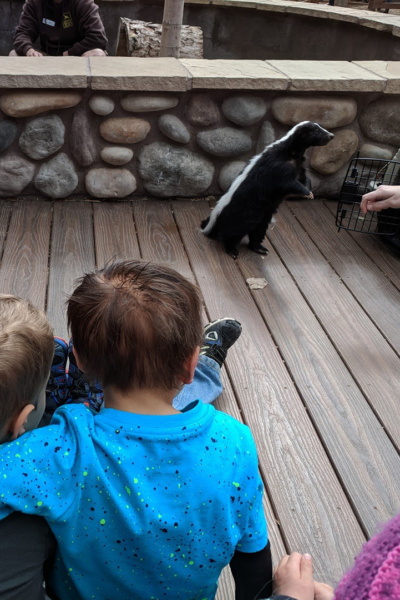


Just a few more weeks, and the kids will be out of school for Spring Break! Wondering how you’re going to fill a week off school with enriching and educational entertainment? Have no fear, Cheyenne Mountain Zoo is here with fun and WILD experiences for your kiddos: Spring Break Zoo Camp, for kids in kindergarten through sixth grade!
Spring Break Zoo Camp is Monday, March 23 through Friday, March 27, 2020. This year, campers will learn about amazing animal adaptations. Animals all over the world have unique adaptations that help them survive in the wild. They’ll learn about – and see, in person – animals’ defense mechanisms, like porcupine quills, and physical traits that help them thrive in their environments, like the long, furry tail of a snow leopard or the water wicking fur of a river otter. After seeing these amazing adaptations with their own eyes, campers are sure to come home with exciting stories to share about their new animal friends.
For the first time ever, CMZoo is offering half-day and full-day options for kindergarten campers. Full-day camps include an additional afternoon snack and some quiet time to rest after lunch. Campers should sign up for the camp that reflects the grade in which they are currently enrolled. All camps include hands-on experiences, up-close animal encounters, games, tours and more, every single day! Register for the whole week, or just a few days.
Space is limited, so visit www.cmzoo.org/camp to register your campers today!
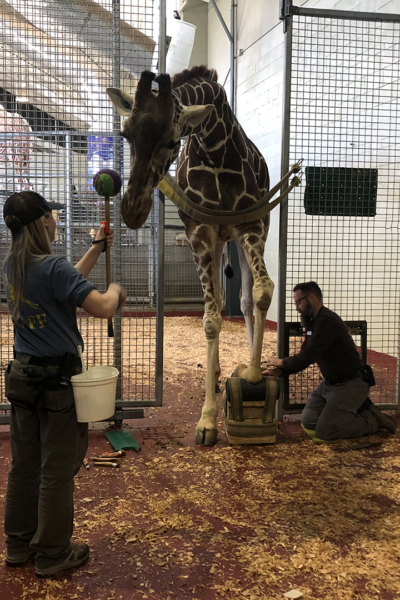

For giraffe, hoof health is vital to overall health. As the zoo profession evolves to further embrace animal husbandry training, and new veterinary technologies allow for better diagnostics, Cheyenne Mountain Zoo is working to improve the future of giraffe care.
“Horses have been domesticated for thousands of years, and the mantra has been ‘no hoof, no horse,’ meaning the overall health of a horse is connected to the health of its hooves. More and more, we’re embracing that for giraffe,” said Dr. Liza Dadone, vice president of mission and programs at CMZoo. “We don’t yet have all the answers, but we have seen that hoof overgrowth changes how the foot supports the weight of a one-ton body. When an animal distributes that much weight differently because of hoof overgrowth, it can have a huge impact on their joints, ligaments and bones.”
Giraffe hooves grow continuously throughout a giraffe’s life. Ongoing hoof maintenance can help prevent issues commonly associated with hoof overgrowth, like lameness and early onset arthritis. Training giraffe to voluntarily participate in hoof maintenance makes preventive care possible, hopefully avoiding these ailments for future generations of giraffe.
Because it’s such an integral part of CMZoo’s work today, some may be surprised to learn that giraffe hoof care is still in its pioneering phase.
“Before our training program started in 2013, we had limited options for managing hoof overgrowth,” said Dr. Dadone. “We also didn’t fully understand what a ‘normal’ giraffe hoof should look like, because we didn’t have consistent access to the underside of the hoof. Training giraffe to participate in their health care has been a total game changer in the level of care we can provide.”
In the last ten years, CMZoo’s Zoo-wide training programs have flourished. The giraffe care team has been recognized nationally for its training success. In just two years, the giraffe care team, led by Animal Care Manager, Jason Bredahl, and Lead Giraffe Keeper, Amy Schilz, developed safety and training protocols and trained the entire herd of giraffe for front foot hoof trims and x-rays.
“It was unheard of,” said Dr. Dadone. “The giraffe were way smarter than we had given them credit for, and this training gave us opportunities to provide ongoing care without anesthesia.”
Hoof care training techniques include asking the animal to voluntarily approach the team, then lift, position and hold its foot so staff can access it safely.
When working around the feet of a 17-foot-tall, one-ton animal, human safety is crucial. The team developed co-working communication that allows one person to train and keep the giraffe’s attention while the other person performs a hoof trim (or other necessary hoof work). Staff learned which kinds of barriers would best protect them and provide adequate access while working safely around giraffe feet. They also studied behaviors in the giraffe so they could recognize when a giraffe might need a break from hoof work.

Once the herd trained to receive x-rays, the care team found that arthritis, ligament injuries, bone damage, and sometimes fractures were present at a rate they weren’t expecting. This discovery led the team to establish a program that included routine front foot x-rays, thermography, visual assessments and monthly hoof trims.
“We can more accurately diagnose and manage giraffe foot health with less invasive procedures, thanks to training,” said Dr. Dadone. “Now that we know giraffe are prone to these issues, we prioritize training of animals from an early age. The goal is that every giraffe, from one year of age, can have its front feet handled and can receive baseline x-rays. The hope is that we can help the next generation of giraffe avoid some of the issues our older giraffe might be experiencing.”
Young giraffe, like Viv, born at CMZoo in July 2019, start training to participate in their care from an early age. Nearly 8-month-old Viv already participates in prerequisite training that will lead to hoof care training. Her keepers say she is shift-trained, which means she will voluntarily move to another area of the barn or outdoor yard when asked. Viv also shifts into ‘the chute,’ which is a narrow part of the indoor barn that some giraffe move through to receive hoof care and other care.
She participates in target training, as well, which means she will touch her nose to a target held by her trainers. For hoof care or x-ray training, target training helps trainers communicate the very specific location the animal is being asked to move to. Likewise, the target helps animals understand what’s being asked of them.
Viv’s keepers have taught her a ‘back up’ command, which helps Viv get into position for hoof care, among other things. They recently started training Viv to get comfortable with being touched, beginning with her shoulders. Once she’s comfortable with being touched on the shoulders, they will continue progress to eventually touch her hooves, which will get Viv even closer to receiving ongoing hoof care.
As CMZoo’s giraffe care team continues finding new ways to improve the health of animals in their care, they learn from and share best practices with the wider giraffe care community. They do this by attending conferences, hosting CMZoo’s annual giraffe care workshops, and through studies, programs and partnerships with Equine Lameness Prevention Organization, Colorado State University Veterinary Teaching Hospital, Giraffe Conservation Foundation and more.
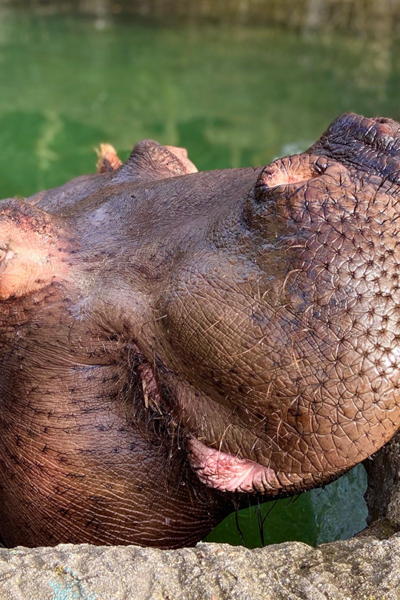

Although Water’s Edge: Africa’s opening date hasn’t been set, Cheyenne Mountain Zoo is steadily preparing to welcome home Zambezi (zam-BEE-zee) and Kasai (kuh-SIGH), two female Nile hippopotamuses who are taking an extended vacation at Dickerson Park Zoo, in Springfield, Missouri. They moved there in 2016 to allow us to build a new state-of-the-art exhibit for them.
Patty Wallace, Water’s Edge: Africa lead animal keeper, worked with Zambezi and Kasai for six years at Cheyenne Mountain Zoo. Wallace spent five of those years as their primary trainer. She is excited for guests to get to know the girls again and to see them in their brand-new home.
Kasai is 20 years old and larger than her older sister, Zambezi. Kasai is easily identifiable by the pink spots on the tops of all four of her feet. Zambezi is 27 years old and has a more consistent skin tone than Kasai. Both hippos enjoy participating in training, but Kasai tends to have a more dominant personality, which often means she’s the first to investigate new enrichment or food.

“I’m really excited about rekindling our relationship and getting to know the hippos again,” said Wallace. “We can expect them to be a little cautious coming into this new building, because they’ve never been there before. Part of the challenge is getting them back to the level of comfort they had before. They’re both really food motivated, so I expect it will take a lot of patience, understanding and watermelon to help the girls gain confidence in their new space and with keepers again.”
Only 30 organizations accredited by the Association of Zoos and Aquariums in North America house hippos. In addition to their somewhat rare presence in zoos, Wallace says part of the CMZoo hippos’ appeal is their generally calm and gentle demeanors.
“Hippos are known as one of the most dangerous animals in the world, with incredibly impressive strength and size,” said Wallace. “Zambezi and Kasai have grown up in human care, so they’re used to people. They may scuffle with each other from time to time, but they really are gentle giants.”
A big part of helping the hippos gain confidence in their new home is training the keepers to control the myriad of new building features that will help them care for Zambezi and Kasai. Keepers are getting accustomed to underwater shift doors, hydraulic doors, garage doors, cable-and-bollard systems, water filtration systems, heating and cooling systems, lighting, behind-the-scenes kitchen and enrichment preparation areas, and more.
“We’re also planning our animal demonstrations and enrichment activities, considering how the girls might like to interact with us in this space and what will give our guests a memorable experience,” said Wallace. “We have a ton of opportunities to help guests fall in love with hippos, thanks to the design of this awesome new space.”
Water’s Edge: Africa’s indoor hippo demo space allows guests to get right up close to the hippos, with only bollards in between them and the animals. In the same area, guests can stand on a scale that helps them see how many humans it takes to weigh the same as a hippo. Near the outdoor hippo yard, a nature trail takes guests to a rope bridge that hangs above the hippo yard, giving guests a first-time bird’s eye view of the girls in water and on land. A knife-edge outdoor pool will help guests see the hippos as the hippos see them – just above the water line.
“You can be eye-level with a basking hippo at the knife-edge pool’s viewing area,” said Wallace. “It is going to be such a cool experience. I can’t wait for everyone to visit the new exhibit and hopefully form long-lasting relationships with these beautiful girls.”
At Dickerson Park Zoo, keepers are working with the girls to make them as comfortable as possible for their trip home to CMZoo, including building the hippos’ comfort level with their transport crates.
“We situated their transport crates so they’re part of the entrance to their yard, which allows them to travel through them and be around them regularly,” said Tracy Campbell, senior zookeeper at Dickerson Park Zoo. Campbell has worked with the girls since they arrived in 2016 and has worked with hippos for 20 years. “Once we have an exact timeline for their trip back to Cheyenne Mountain Zoo, we’ll increase their crate training time, but for now we’re keeping them acclimated by walking through them.”
Wallace was part of the transport training when the girls first traveled to Springfield.
“We trained with them for about three months before their last transport,” said Wallace. “They traveled in separate crates made of wood and steel. Like Dickerson Park Zoo is doing, we positioned the crates as entrances to the building, so they could walk through them and gain confidence with them over time. They were hesitant at first, but since they’re so food motivated, it didn’t take them long to get the hang of it.”
The trip between Dickerson Park Zoo and Cheyenne Mountain Zoo takes about 11 hours. The hippos travel in their crates inside an enclosed and climate-controlled flatbed truck. Once the hippos are comfortably in their crates, a large crane is used to move the 1.5-ton animals onto the truck. During the transport, the hippos are monitored to address any needs along the way. All went smoothly last time, and CMZoo keepers stayed with the girls at DPZ for about a week to help them settle in.
“I’m excited to have the girls home again,” said Wallace. “In the mornings, I would call ‘good morning, hippos!’ and they’d vocalize and poke up out of the water to look for me. They’d watch and wait for me to prepare their breakfast – and they’d let me know if I was being too slow. They’d walk up the ramp and stare at me, watching my every move. I can’t wait to see them and our guests exploring this amazing new exhibit.”
The International Union for Conservation of Nature (IUCN) Red List categorizes Nile hippopotamuses as a species vulnerable to extinction in the wild, estimating 125,000 to 150,000 remain in their native habitats. The primary threats are habitat loss and illegal and unregulated hunting. Hippos are hunted for ivory, which is found in hippopotamuses’ canine teeth, and meat.
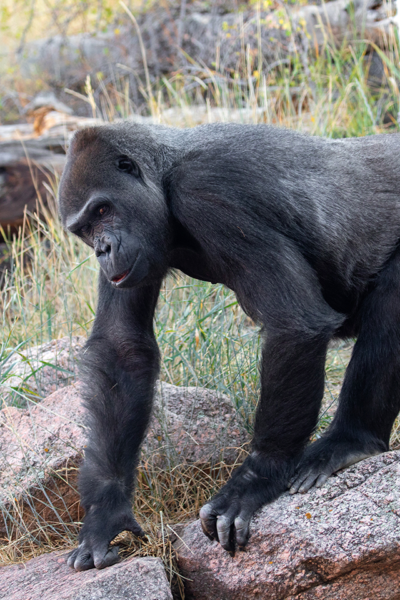

Seasonal illnesses, like influenza, can wreak havoc on humans this time of year. But, did you know great apes, like orangutans and gorillas, are also susceptible to the flu virus, which impacts an estimated 3 million humans annually?
As Cheyenne Mountain Zoo’s year-round sponsor, Children’s Hospital Colorado, provides tips for staying healthy during flu season, Primate World keepers take steps each year to help great apes stay as healthy as possible.
“The great apes are the most susceptible to illnesses that impact human primates, like you and me,” said Dina Bredahl, senior lead keeper in Primate World. “Any primate at the Zoo can catch illnesses from humans, but the risk is increased for great apes because they’re so similar to humans. Orangutans share 97 percent of the same DNA as humans.”

To protect the Bornean and Sumatran orangutans and the Western lowland gorillas at CMZoo, the apes receive the flu vaccine. The flu vaccine is administered by injection, which the Primate World residents train to accept voluntarily. Flu shots are available each fall, but injection training continues throughout the year nearly every day. The training can take months and requires the apes to build upon the trust they have in their keepers. Some of them choose not to participate in injection training, or may not be at a point in their training that keepers feel confident a real injection won’t derail the progress.
“We rely on ‘herd immunity’ to protect the population, so not every single great ape will receive a flu shot,” said Bredahl. “As long as a majority of the gorillas and orangutans receive the vaccine, we drastically reduce their overall risk.”
One example is one-year-old Sumatran orangutan, Kera. Little Kera was at a point in her training that her primary keeper thought a real first-time ‘poke’ might risk a regression in her training. Because the majority of the other primates were further along in training, Kera didn’t receive a shot during the fall flu shot clinic. However, her primary trainer continued training, and Kera has made incredible progress. So much progress, in fact, that she gets excited for the training.
“We’ll use a syringe that doesn’t have a needle, so they get used to seeing the shape and being touched with it,” said Bredahl. “Eventually, we move on to a dull needle, so it looks more similar to the needle we’d use for an actual injection. Kera’s trainer has been so successful that Kera now knows if she presents her hip and then holds still for a moment for the pretend injection, she’ll get a special reward. She presents her hip pretty enthusiastically, which is adorable and impressive since she’s still just an infant!”
Keepers also take steps to avoid transmitting diseases to the great apes.
“Primate World keepers receive flu shots yearly to protect ourselves and the great apes in our care,” said Bredahl. “We also wear medical masks when we prepare their food or are in close protected proximity to them. We wash our hands constantly and practice good hygiene before and after we handle anything they’ll touch or eat.”
Guests can visit CMZoo’s three Bornean orangutans, three Sumatran orangutans and five Western lowland gorillas – and can even see their training during scheduled demonstrations – in Primate World.
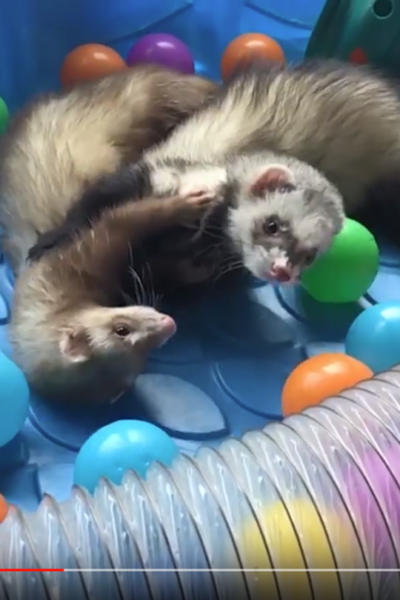

Cheyenne Mountain Zoo has welcomed two domestic ferrets to The Loft! 1-year-old male, Alfred Pennyworth, and 3-year-old female, Harley Quinn, are already target training, create training, meeting guests and learning how to interact on ZOOMobile programs. Come by The Loft and meet this energetic duo next time you’re at the Zoo!
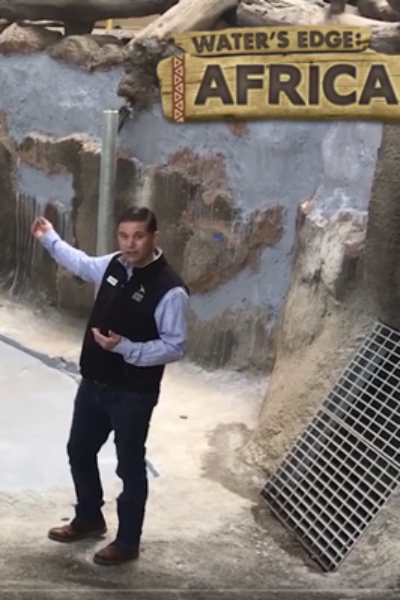

Bob Chastain, CMZoo president and CEO, is back with the latest update from Water’s Edge: Africa. We’ve refilled the void in the soil under the indoor hippo pool and waterproofed the new concrete. Soon, we’ll do another water test to measure continued water loss.
Get an up-close view of the micro cracks that we’re repairing with a filler product that has some elasticity. We hope the lining material we apply next will stop those leaks.
Also, in this video, we’re giving you a first-time sneak peek at the Water’s Edge: Africa vacation yard. This outdoor yard and pool will be used by a variety of animals and will be visible to guests on their way to Primate World.
Although we don’t yet have an opening date, we’re getting closer! We’re still aiming to begin introducing animals to the building sometime in March. We’ll keep you posted!
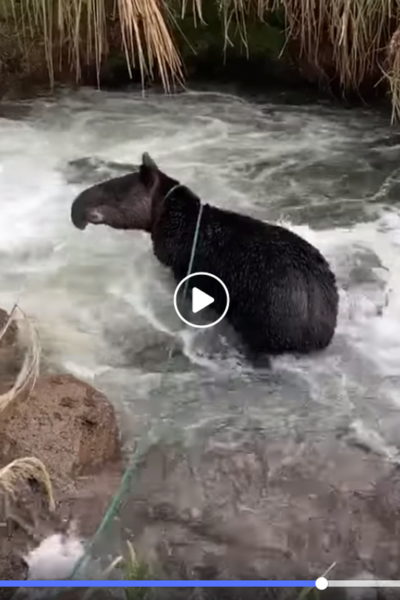

A team of four CMZoo staff members traveled to Ecuador in December to track critically endangered mountain tapir and speak to local school children about the native species.
They successfully studied and attached GPS collars to five wild tapir. The collars will relay data to prove the roaming ranges of tapir in the Andes Mountains, which we hope will be used to establish protections for their threatened natural habitats.
CMZoo members have voted three times to support ongoing mountain tapir research and conservation efforts in Ecuador. During the upcoming Membership Conservation Grant Vote, members will help us decide again which projects receive part of the $75,000 of membership revenue annually allocated for these grants.
https://www.facebook.com/CMZoo/videos/236694087334330/